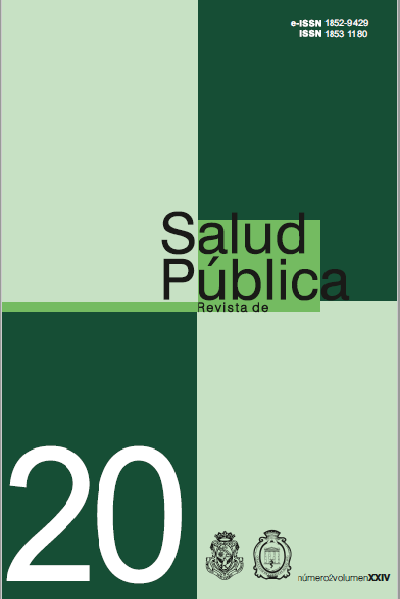Use of antimicrobials in veterinary practices of pets, at the city of Córdoba, Argentina.
DOI:
https://doi.org/10.31052/1853.1180.v24.n2.27156Keywords:
Pets, Veterinarians, Anti-Infective AgentsAbstract
Abstract
The inadequate use of antimicrobials (ATM), has as a consequence the increase of the germs’ resistance; current problem in public health. The objetive of the present proyect, was to identify the use and prescription of the ATM utilized at companion animals’ clinic, at the city of Córdoba, Argentina. An observational study was carried out through a questionnaire composed by 18 questions. The 98% (149 of 152) of surveyed professionals, empirically utilized ATM, being penicilin and other drugs based on it, the most commonly employed. Against skin and urinary syndromes, it was perceived a higher statistical probability of empirical prescription (2, 08 for skin syndromes and 3, 22 for urinary syndromes). Because of the high frequency observed in the utilization of ATM, and the fact that some of them are clasified as "of crytical importance" in human medicine, it is necessary to count with local epidemiological data, to be able to guide the initial empirical tratments, and to create vigilance and control programs destined to regulate them.
Downloads
References
1. Organización mundial de la Salud [Internet]. Resistencia a los antibióticos. OMS; 2018 [Consultado 18 de Nov 2019]. Disponible en: https://www.who.int/es/news-room/fact-sheets/detail/resistencia-a-los-antibi%C3%B3ticos.
2. Errecalde JO. Uso de antimicrobianos en animales de consumo. Roma: FAO; 2004 [Consultado: 18 Nov 2019]. Disponible en: http://www.fao.org/3/y5468s/y5468s02.htm
3. Cordera J. Detectan bacterias multirresistentes a los antibióticos en el río Suquía y en el ambiente de Córdoba [Internet]. Córdoba-Argentina: UNCiencia; 16 de Oct 2019. [Consultado: 18 Nov 2019]. Disponible en: http://www.unciencia.unc.edu.ar/2019/octubre/detectan-bacterias-multirresistentes-a-los-antibioticos-en-el-rio-suquia-y-en-el-ambiente-de-cordoba
4. Quiñones Perez D. Resistencia antimicrobiana: evolución y perspectivas actuales ante el enfoque “Una Salud”. Rev Cubana MedTrop [Internet] 2017 [Consultado: 18 Nov 2019]; vol 69(3). Disponible en:http://scielo.sld.cu/scielo.php?script=sci_arttext&pid=S0375-07602017000300009
5. Sopena N, Sabria M. Staphylococcusaureus resistente a la meticilina. MedClin (Barc). 2002; 118(17):671-6.
6. LevyS. (1998). Multidrug resistance - a sign of the times. New England medicines report and qualitative risk assessment. Journal of Medicine338:1376-1378.
7. Organización Mundial de la Salud. Dejemos de administrar antibióticos a animales sanos para prevenir la propagación de la resistencia a antimicrobianos [Internet]. OMS; 2017 [Consultado 18 Nov 2019]. Disponible en: https://www.who.int/es/news-room/detail/07-11-2017-stop-using-antibiotics-in-healthy-animals-to-prevent-the-spread-of-antibiotic-resistance
8. Casellas MJ, Pantozzi F, Martiarena B, Tomé G. Los animales compañeros (mascotas) como fuente de infecciones por Staphylococcus meticilino resistentes, bacilos gramnegativos productores de BLEE e infecciones urinarias. La Gaceta Inf. Mic Clin. 2010; 4(4):3.
9. EMEA. (1999). EMEA/CVMP/342/99 final report: antibiotic resistance in the European Union associated with therapeutic use of veterinary medicines - report and qualitative risk assessment.Disponible en: http://www.ema.europa.eu/docs/en_GB/document_library/Report/2009/10/WC500005166.pdf).
10. Berkson, J. Application of the Logistic Function to Bio-Assay. Journal of the American Statistical Association, 1944; 39(227), pp. 357-365. DOI: 10.2307/228004
11. Akaike, H. A New Look at the Statistical Model Identification. IEEE Transactions on Automatic Control, AC- 19, pp. 716-723. http://dx.doi.org/10.1109/TAC.1974.1100705
12. Alvo V, Andrés, Téllez G, Valentina, Sedano M, Cecilia, Fica C, Alberto. Conceptos básicos para el uso racional de antibióticos en otorrinolaringología. Revista de otorrinolaringología y cirugía de cabeza y cuello. 2016; 76(1), 136-147. https://dx.doi.org/10.4067/S0718-48162016000100019
13. Gómez-Poveda B, Moreno MA. Antimicrobial Prescriptions for Dogs in the Capital of Spain. Front. Vet. Sci. 2018; 5:309.
14. Montone F, Dib A, Suárez G. Prescripción de antimicrobianos en la clínica de pequeños animales en el departamento de Montevideo. Veterinaria (Montev.). 2017; 53:207.
15. Organización Mundial de la Salud. Farmacorresistencia [Internet]. OMS; 2019 [Consultado 18 Nov 2019]. Disponible en: https://www.who.int/drugresistance/use/es/
16. Moreno MA, Castillo MA, Atilio, Ferrebuz J, Osorio W, Zambrano O, María, Caycedo T, Diana, Velandia P. Resistencia bacteriana en pequeños animales, potencial riesgo para la salud humana. Revista Electrónica de Veterinaria. 2018; 19 (2).
17. González del Castillo J, Núñez Orantos MJ, Candel FJ, Martín-Sánchez FJ. Las consecuencias de la terapia antibiótica empírica inapropiada en función de la situación clínica del paciente. EnfermInfeccMicrobiolClin. 2017; 35 (7):472-473.
18. Mateus A, Brodbelt DC, Barber N, Stärk KD. Antimicrobial usage in dogs and cats in first opinion veterinary practices in the UK. J Small AnimPract. 2011; 52 (10):512-21.
19. Buckland EL, O´Neill D, Summers J, Mateus A, Church D, Redmond L, Brodbelt D. Characterisation of antimicrobial usage in cats and dogs attending UK primary care companion animal veterinary practices. Vet Rec. 2016; 179 (19):489.
20. European Medicines Agency [Internet]. Science Medicines Health. Reino Unido: European Medicines Agency; 2019 [Consultado: 18 de noviembre 2019]. Disponible en: https://www.ema.europa.eu/en/documents/other/answer-request-european-commission-updating-scientific-advice-impact-public-health-animal-health-use_en.pdf
21. Vigo GB, Giacoboni GI, Gagetti PS, PasteránFG, Corso AC. Resistencia antimicrobiana y epidemiología molecular de aislamientos de Staphylococcus pseudintermedius de muestras clínicas de caninos. Rev Argent Microbiol. 2015; 47 (3):206-211.
Downloads
Published
Issue
Section
License
Copyright (c) 2020 Escuela de Salud Pública y Ambiente. Facultad de Ciencias Médicas. Universidad Nacional de Córdoba

This work is licensed under a Creative Commons Attribution-NonCommercial 4.0 International License.
Authors who have publications with this journal agree to the following terms:
The generation of derivative works is permitted as long as it is not done for commercial purposes.
The original work may not be used for commercial purposes.
Authors are allowed and encouraged to disseminate their work through professional social networks or on their website, after the publication process, in order to increase the visibility of their research.







